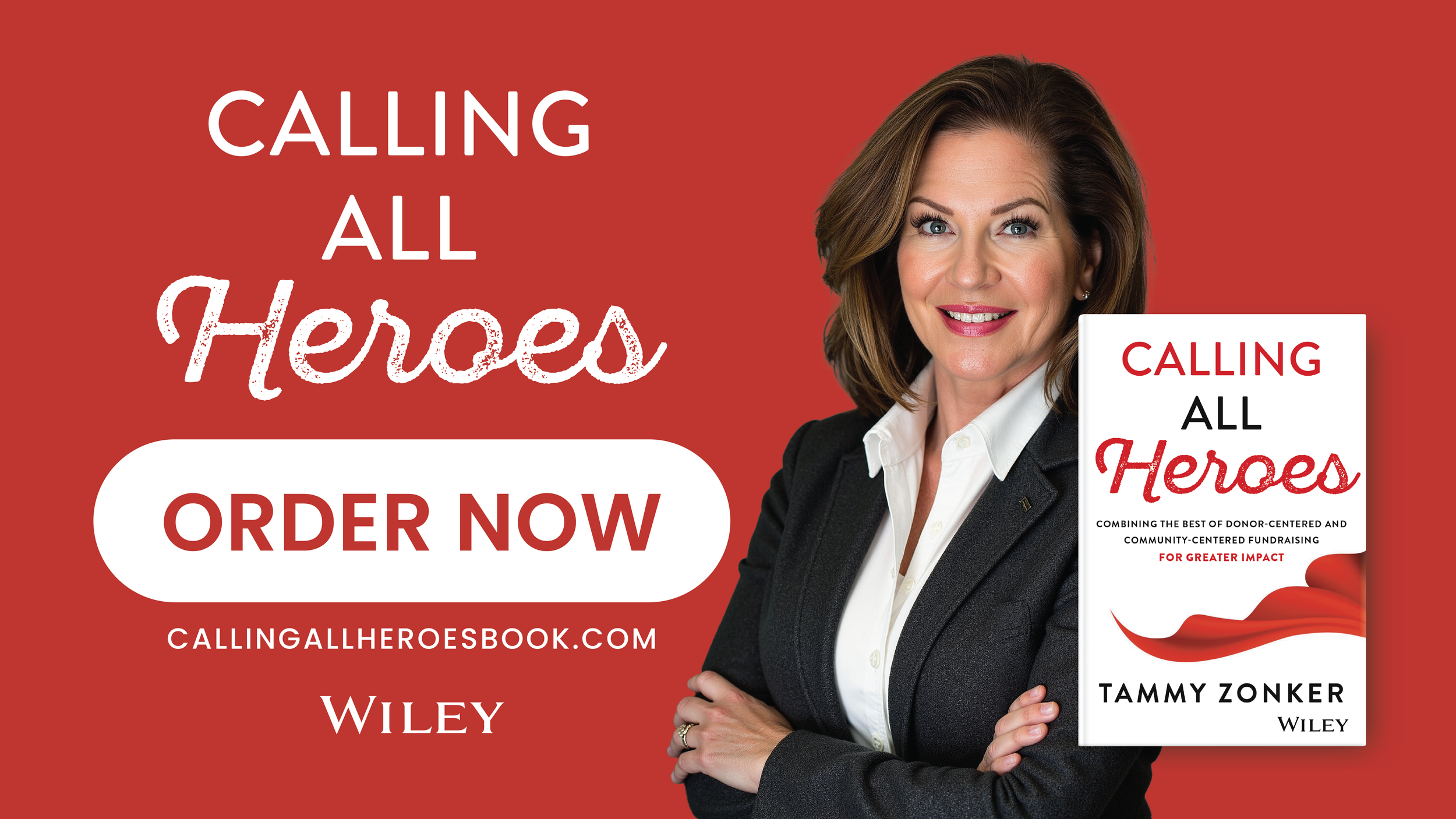Why I Wrote "Calling All Heroes": A Letter to All Nonprofit Stakeholders
Scaling Major Gifts. Strategies, action steps, and ideas for scaling major gifts by Tammy Zonker, Major Gift Expert & Keynote Speaker.
A Personal Call to the Sector
After nearly three decades in the trenches of fundraising—working alongside major gift officers, development directors, executive directors, and board members—I’ve seen firsthand the incredible power and potential of our sector. Yet I’ve also felt the weight of its challenges, the isolation that can come from “going it alone,” and the frustration of seeing well-intentioned debates divide us when unity is what we need most.
That’s why I wrote Calling All Heroes. This book is my invitation—and my challenge—to all of us who believe in the transformative power of philanthropy. I wanted to offer a roadmap that blends the best of donor-centered and community-centered fundraising, grounded in real-world experience and a profound respect for every stakeholder in our missions.
The Pain Points We All Know
In my experience, the most common pain points we face aren’t just about dollars and cents. They’re about people, power, and purpose. Here are a few I’ve encountered time and again:
Division over fundraising models: The sector often feels split between donor-centered and community-centered philosophies, with passionate advocates on both sides. This debate can sap our energy and distract us from our shared goals.
Mission drift and power imbalances: I’ve seen organizations veer off course in pursuit of major gifts, sometimes at the expense of their core mission or the dignity of those they serve.
Burnout and turnover: The relentless pressure to “do more with less” leaves many of us exhausted, and staff turnover remains chronically high.
Lack of diversity and inclusion: Despite our best intentions, too many teams and boards still don’t reflect the communities we serve, which limits our effectiveness and reach.
Measuring what matters: We’re often so focused on fundraising totals that we forget to track the deeper, human-centered impact of our work—on donors, beneficiaries, and communities alike.
Strategies That Have Made a Difference
Over the years, I’ve learned that the most effective solutions are both practical and rooted in empathy. Here are a few approaches I’ve seen move the needle:
1. Blending Models, Not Choosing Sides
I’ve found that the most resilient organizations are those that refuse to be boxed in by a single philosophy. Instead, they blend elements of donor-centered and community-centered approaches, creating what we refer to as “human-centered fundraising.” This means honoring donors’ motivations while ensuring community wisdom and voices are central to decision-making.
2. Building Diverse, Collaborative Teams
One approach I’ve seen work well is intentionally recruiting and supporting diverse fundraising teams—across race, age, background, and lived experience. When everyone has a seat at the table, innovation flourishes, trust is strengthened and constituent engagement deepens.
3. Transparent Communication and Power Sharing
I’ve learned to embrace honest conversations with donors—even when it means respectfully correcting misconceptions or pushing back on ideas that don’t align with our mission. Transparency builds trust and keeps the organization’s purpose front and center.
4. Leveraging Technology Without Losing the Human Touch
AI and digital tools can free us from repetitive tasks and help personalize donor engagement at scale. But the transformation happens when technology amplifies, rather than replaces, authentic relationships.
A Real-World Example: The Children’s Center in Detroit
Let me share a story from my own journey. On the heels of the Great Recession, I worked with The Children’s Center in Detroit—a beacon of hope facing daunting financial and operational challenges. By rallying leadership around a shared vision, overhauling donor communications, and building a high-performing, diverse development team, we tripled philanthropy in three years and doubled it again in the next six. But more than the numbers, what mattered was the transformation in culture: donors, staff, and community members felt seen, heard, and valued as partners in the mission.
Current Data: Why Change Is Urgent
Donor retention rates remain alarmingly low: According to the Fundraising Effectiveness Project, only 19% of first-year donors gave again in 2024, and fewer than 50% of second-year donors continued—a costly cycle for all of us.
Diversity drives results: Organizations with three or more BIPOC fundraisers are significantly more likely to adopt community-centric practices and see positive shifts in morale and revenue over time.
AI adoption is rising: 82% of fundraisers are now comfortable using AI for outreach, but 63% remain cautious about authenticity—underscoring the need for balance.
Actionable Takeaways for Your Organization
Here are steps you can take right now, based on what I’ve learned:
Conduct a fundraising audit. Assess not just your revenue, but your donor retention, team diversity, and stakeholder engagement.
Map your donor and community journeys. Identify every touchpoint and ask: Are we building authentic relationships, or just facilitating transactions?
Pilot a blended approach. Start small—perhaps by inviting both donors and community members to co-create a campaign or event. When you’re ready to explore my guide for implementing this approach, turn to “Chapter 9: The Hero’s Journey—Implementing the Human-Centered Model” in my book Calling All Heroes for a deeper dive.
Invest in your team. Prioritize training in relationship-building, community engagement, and inclusive leadership.
Measure what matters. Track not just dollars raised, but lives touched, satisfaction scores, and collaborative impact.
Have courageous conversations. Don’t shy away from having deeper conversations with donors or board members when their ideas don’t align with your mission or values. Be curious, seek to understand, and when necessary, make a stand for staying firmly rooted in yours beliefs, va’s beliefs, values, and strategic vision.
We Are Stronger Together
If there’s one thing I hope you take away from Calling All Heroes, it’s this: Our sector’s strength lies in our ability to unite—across philosophies, backgrounds, and roles. The challenges we face are too big and complex for any single hero. But together, we can build organizations where every donor, volunteer, community partner, program participant, and staff member feels like a valued part of the story.
In my experience, the most meaningful progress happens when we listen deeply, act courageously, and refuse to let old divisions hold us back. I invite you to join this movement—share your own stories and ask courageous questions.
We’re all heroes in this work. Let’s rise to the challenge, together.
Pre-order your copy of Calling All Heroes today, enter your receipt/order number, and receive your exclusive invitation to my free, LIVE, 90-minute training session (CFRE-accredited), How to Implement Human-Centered Fundraising in Your Organization.
→ Pre-order here: https://callingallheroesbook.com
Keep scaling,
Tammy Zonker
Author, Major Gift Expert & Keynote Speaker
President, Fundraising Transformed
President & Dean, Modern Institute for Charitable Giving
ps – Please share this ❤️

